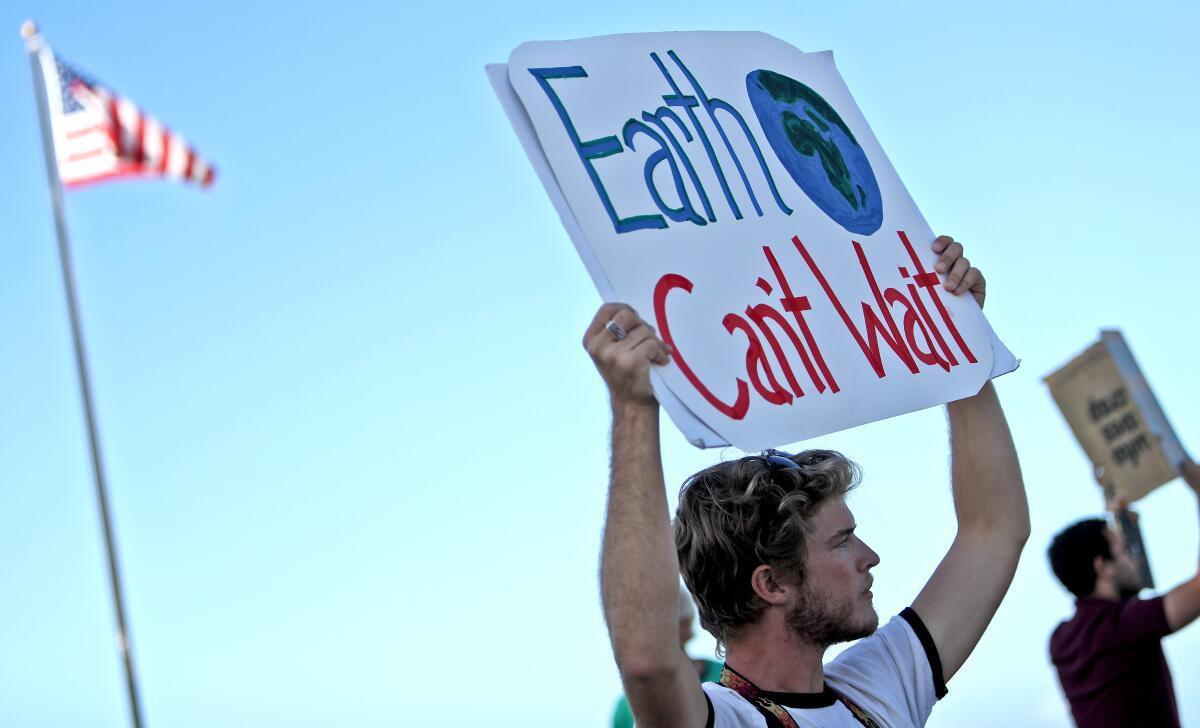Op-Ed: Is climate anxiety bad for the planet?

The American Psychological Assn. defines “eco-anxiety” as a “chronic fear of environmental doom.” Lots of people are feeling it.
A 2020 survey of people ages 8-16 showed that 73% were worried about the state of the planet. Since 2009, the number of Americans worried about the threats posed by climate change increased by 44%. Two-thirds of Americans are worried about climate change, and these numbers are still on the rise.
But if it takes anywhere between 10% to 51% of any given population to care about an issue to make significant change, why hasn’t all this climate anxiety led to more dramatic change?
Contrary to popular progressive belief, we don’t necessarily need to get more people to care about the climate; climate anxiety is rampant, and people overwhelmingly care enough to tip the scales.
Perhaps the answer lies in the term itself. Perhaps climate anxiety as a concept fails to motivate the kind of changes we need to see. As the science writer Britt Wray has argued, the term runs the risk of pathologizing and depoliticizing the problem, making it solely a mental health concern rather than a systemic problem rooted in economic, historical and social structures. Assuaging individuals’ climate anxiety without challenging these systems only addresses the symptoms, not the causes, and places the burden of fixing the problem on individuals.
A second problem with “climate anxiety” as a term is that it is too amorphous to conjure the kinds of actions required to mitigate climate change. We feel too small to do anything about it. Climate change in general is hard for people to perceive as a risk because it is too big, too far, or too in the future, to feel in time and space. It seems uncannily designed to not be perceived as a risk. We may feel climate change’s effects, such as increased heat, extreme weather events, rising sea levels and more infectious diseases like COVID, but climate change itself is imperceptible. It is thus hard to figure out what our object of worry is, and so we don’t know what to do to avoid the threat. In other words, climate just doesn’t make the cut as a villain in this story — it isn’t like a burglar breaking into your house at night, or even your house on fire, as Greta Thunberg, the Swedish activist, asks us to imagine.
If COVID showed us that it’s possible to not perceive a more immediate threat such as a deadly virus, what hope does climate change have? The solution may be to call climate change by its many ripple effects: pollution, disease, injustice, displacement, the list goes on. We can make it more perceivable by focusing on one of its myriad tendrils. This will help us feel there’s something in our sphere of influence that we can tackle.
Feeling too small to tackle the problem can cause us to feel apathy, nihilism, despair and what mental health professionals might call a “hijacked amygdala.” The sense of being in a constant state of alert triggers the part of the brain that wants to survive — the “fight, flight, or freeze” instinct — which bypasses the rational part of the brain.
No wonder we feel powerless: access to 24/7 news (most of which portrays climate change in a doomsday frame) and our addictive doom-scrolling makes the problem seem so big that it’s not even worth fighting. The reality is bad, but believing that an apocalypse is inevitable is a self-fulfilling prophecy. In fact, an army of people is working to address climate change from every imaginable angle; they’re just not covered in the news that most of us consume.
Anxiety is an understandable and appropriate response to the ecological devastations people are experiencing around the world. But there isn’t an automatic connection between individual climate anxiety and collective climate action. This is because most of us don’t know how to engage the political process as a collective, and because most of us don’t know how to use uncomfortable emotions for that collective work. We need to channel our negative emotions to building community, rather than wringing our hands over how insignificant our actions feel.
We can do this by finding others who feel the urgency as we do, who see the connections between climate and other social ills, and who also want to channel their worry into action. Communities like this are all around us at both the national and local levels, from the Just Transition and Sunrise Movements to mutual aid and sustainability programs in your schools, churches and places of employment. You can help make sure your local green spaces are accessible. You can contribute to a community garden. You can learn the indigenous practices of the land you are on. You can support young people who care about climate justice.
We needn’t remove carbon from the atmosphere in one fell swoop to be effective in addressing climate change. We need to start where we are, use the talents we already have, and plug into groups and communities that are already doing the work. Building community around action should be our measure of success, and it can happen right now. When we are working to nurture what we value, it gives us a sense of control which is an antidote to anxiety.
You can use your climate anxiety for immense good. The planet needs you to be resilient, not anxious to the point of debilitation. Paying attention to your mental health, in this case, will help the survival of life on the planet.
Sarah Jaquette Ray teaches environmental studies at Humboldt State and is author of “A Field Guide to Climate Anxiety: How to Keep Your Cool on a Warming Planet.”
More to Read
A cure for the common opinion
Get thought-provoking perspectives with our weekly newsletter.
You may occasionally receive promotional content from the Los Angeles Times.










